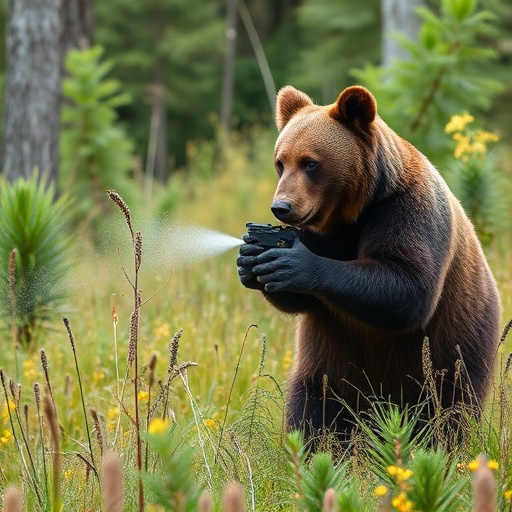Bear spray, a potent defense against black bears, primarily contains capsaicin from chili peppers and piperidine carboxylic acid (PCA), irritating sensitive areas to temporarily deter bears. Different brands have unique formulations, so checking labels is crucial. Effective use requires proper application techniques, considering weather and bear behavior. Understanding the chemistry ensures users are equipped when encountering bears. Always refer to product labels and safety guidelines for optimal protection while outdoor recreation.
“Braving the outdoors? Then knowing how to defend against black bears is crucial. In this comprehensive guide, we’ll explore the effectiveness of bear spray as a vital tool for safety in bear country. From understanding its composition and chemical components like capsaicin and pepper compounds, to choosing the right spray for your needs and mastering proper usage techniques, you’ll gain essential knowledge for maximum protection during outdoor adventures. Stay safe, stay informed.”
- Understanding Bear Spray: Composition and Effectiveness
- Choosing the Right Bear Spray for Your Needs
- Proper Usage and Safety Tips for Maximum Protection
Understanding Bear Spray: Composition and Effectiveness
Bear spray, also known as bear repellent, is a powerful tool for personal safety when encountering black bears in their habitat. Understanding its composition and effectiveness is crucial before considering it as a defense mechanism. The primary active ingredient in most bear sprays is capsaicin, derived from chili peppers. This chemical irritates the eyes, nose, and respiratory system of the bear, temporarily disorienting it and creating an opportunity for escape or a safe retreat.
Other components include various oils, solvents, and sometimes fragrances to enhance the spray’s effectiveness and user experience. The spray creates a barrier of capsaicin around the user, making it difficult for the bear to approach without experiencing discomfort. It’s important to note that different brands and formulations may have unique compositions, and checking the label for specific ingredients is essential. Effectiveness can vary based on factors like weather conditions, bear behavior, and distance, so users should follow instructions and ensure proper application techniques for optimal protection.
Choosing the Right Bear Spray for Your Needs
When selecting bear spray, understanding what chemicals are contained within it is paramount. Different sprays use various active ingredients, each with its own strengths and weaknesses. Common chemicals include capsaicin, a pepper-based compound that irritates the eyes and respiratory system, and piperidine carboxylic acid (PCA), which disrupts a bear’s sense of smell. Some brands even incorporate natural elements like plant extracts for enhanced effectiveness and reduced environmental impact.
The right spray for you depends on your specific needs and local bear behavior. For example, if you’re hiking in areas with black bears known to be less aggressive, a lower concentration spray might suffice. Conversely, grizzly bears tend to be more defensive, necessitating a higher strength formula. Always read product labels and follow manufacturer recommendations to ensure optimal protection during outdoor activities.
Proper Usage and Safety Tips for Maximum Protection
To ensure maximum protection against black bears, it’s crucial to understand proper usage and safety tips for bear spray. First, always check the expiration date before each use, as the effectiveness of the spray decreases over time. Next, familiarize yourself with the recommended distances for application; typically, you should aim for a 2-3 meter (6-10 foot) range, but follow product instructions specific to the brand and type of bear spray you have.
When using bear spray, maintain a calm demeanor and point the nozzle away from yourself and others before activating it. Aim high, towards the bear’s face and upper body, as this is where the spray will be most effective in causing temporary blindness and irritation. Never run or turn your back on a bear; instead, create distance slowly while spraying. Remember that what chemicals are in bear spray—like capsaicin, oleoresin capsicum, and other irritants—can cause severe reactions, so it’s vital to treat the spray with respect and follow safety guidelines strictly for optimal protection.
Bear spray is a valuable tool for protecting against black bears, but its effectiveness depends on proper usage and choosing the right product. Understanding the chemicals within bear spray, such as capsaicin and pepper-based agents, ensures you’re equipped with a reliable defense. By following safety tips and selecting a spray tailored to your specific needs, you can navigate encounters confidently while minimizing harm to both yourself and the bears. Stay informed, be prepared, and enjoy your outdoor adventures safely.
